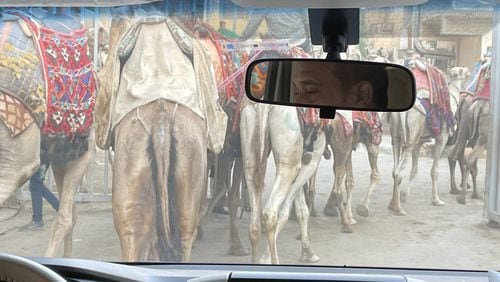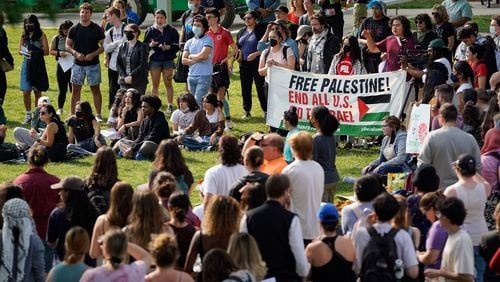This traffic column is normally a space that advocates for and examines traffic rules and safety, humane driver behavior, and easing commuter gridlock. Naturally, the first entry for 2024 would center around a country that seems quite unconcerned with any of that.
My wife, Momo, and I traveled to Egypt just before Christmas and, as one might expect, explored the ancient pyramids and ruins in Cairo-Giza, Aswan, and Luxor. We did not drive ourselves, but rode as passengers in tour company vans or in Uber rides. We spent hours riding the roads in those cities and between Aswan and the Abu Simbel temple three and a half hours south of it. The main rules of the road are that there are none.
Traffic is most intense and anarchistic in Cairo, the country’s capital and home to more than 20 million. While public transit is prevalent and many buses traverse the giant city, small cars choke the streets and smog dirties the desert air. But the sheer presence of bad traffic in a giant city was not eye-opening.
The stark difference between Cairo’s drivers and Atlanta’s was the sheer lack of rules and the close quarters in which each driver played their game of take-only. Dozens of cars slowly weave through intersections — without the direction of traffic signals — and somehow snake by unscathed. Lane markings are only suggestions, as cars, vans, trucks stacked with goods, motorized tricycles, and motorcycles straddled would-be lanes or just created their own as the gaps allowed.
Drivers often use turn signals, but only as warnings and not questions. If spaces in the desired lane open, they take them immediately. Or they just drive into a lane until someone lifts. This is a successful game of chicken played numerously and normally with good results.
Cairo drivers’ “take-only” mentality works mainly because traffic moves so slowly there. They have plenty of time to judge for or prepare for a maneuver. Pedestrians (including yours truly) can confidently step into oncoming traffic without crosswalks or signals because they are expected to. But walkers can also jut out into oncoming traffic because of its speed. The slower speeds mean there is plenty of time to react. Anyone who wants to get somewhere has to grow comfortable with taking their turn, not waiting for it. The chicken just has to step into the road and expect the cars to stop or go around them, if they want to get to the other side.
Car horns are far less pejorative in this driving culture. People honk horns to let someone know they are coming, that they are turning, or to give an elbow nudge to a slow-moving vehicle in the way. They rarely are used to vent frustration, best we could tell. And the horn sounds are nearly non-stop in Cairo; we heard them loudly — even late at night from our 24th-floor room.
Because drivers are expected to take what they need, they seem to take far less offense than Atlanta drivers do when that is done to them. Because chaos is expected, motorists mildly receive it. The seeming lack of angst in traffic in Egypt is refreshing.
This madness seems to mirror the driving conditions in numerous foreign cities that I have both experienced (Istanbul and Beijing) and read about (Mexico City and Mumbai). But just because the craziness of Cairo’s roads is common elsewhere does not make it necessarily more safe. It is just safer than we would expect in comparison to roads in the U.S., which have more rules (and seemingly less bad behavior).
WHO stats in 2020 showed Egypt with 11.77 deaths per 100,000 people — a rate of 1.89% — 116th worst in the world. The U.S. is only four spots better at 120th worst in the world (11.1 deaths/100K) out of 183 countries.
Both countries behave far differently and yet are relatively safe. The Dominican Republic has more than 67 deaths per 100,000 people, making it the deadliest country in traffic.
But Egyptians seem more resigned to or relaxed about their driving environment than Americans do. Maybe that has some mental health benefits over time. Not taking things too seriously has a life-giving and life-prolonging effect. It at least saves some bruising from angrily slamming the steering wheel too much.
We took the metro train in Cairo, crossed those busy streets on foot, rode camels around the pyramids, rode on the back of a motorized trike (driven by a 15 year-old) up a village hilltop, took a few Uber rides, and took a three-hour trip on a passenger train that seemed straight out of the 1970s. But the most eye-opening transportation mode we took in Egypt was certainly the automobile.
Driving in Egypt, especially Cairo, is completely different than here in the States. And while the lack of rules, the take-only aggression, the dearth of traffic signals, and zero accommodations for pedestrians is stark and, objectively, highly unsafe, it somehow still works. Egyptian drivers and walkers have to have their heads on swivels at all times and cannot afford to overly outpace their cohorts. They also drive smaller, cheaper cars, many of which wear the proof that they travel in close quarters.
The presence of danger or change at every bend is its own, tidal form of rule in Egypt’s streets.
Doug Turnbull, the PM drive Skycopter anchor for Triple Team Traffic on 95.5 WSB, is the Gridlock Guy. Download the Triple Team Traffic Alerts App to hear reports from the WSB Traffic Team automatically when you drive near trouble spots. Contact him at Doug.Turnbull@cmg.com.
About the Author






